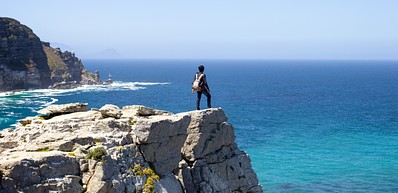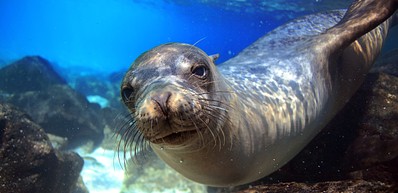
-
![man posing on a cliff at Cape of Good Hope]() Provided by: Rahul Chakraborty/unsplash
Provided by: Rahul Chakraborty/unsplash -
![Cape of Good Hope]() Provided by: Neil Bradfield/Shutterstock.com
Provided by: Neil Bradfield/Shutterstock.com

Our travel guides are free to read and explore online. If you want to get your own copy, the full travel guide for this destination is available to you offline* to bring along anywhere or print for your trip.
*this will be downloaded as a PDF.Price
€4,95
Cape of Good Hope & Cape Point
The guide was updated:Cape of Good Hope and Cape Point are two of the most famous and popular tourist spots in Cape Town. There is a misconception that the Cape of Good Hope is the most southern tip of Africa, which is not true, as in fact Cape Agulhas is the southernmost point. Both the Cape of Good Hope and Cape Point are sections of the Table Mountain National Park, where you can see cape lions, spotted hyenas, jackals, elephants and zebras.
Useful Information
- Address: Cape of Good Hope, Cape Town
- Website: www.sanparks.org/parks/table_mountain/tourism/attractions.php#goodhope
- Phone: +27 21 780 9204
Digital Travel Guide Download
Our travel guides are free to read and explore online. If you want to get your own copy, the full travel guide for this destination is available to you offline* to bring along anywhere or print for your trip.
*this will be downloaded as a PDF.Price
€4,95

Cape of Good Hope and Cape Point are two of the most famous and popular tourist spots in Cape Town. There is a misconception that the Cape of Good Hope is the most southern tip of Africa, which is not true, as in fact Cape Agulhas is the southernmost point. Both the Cape of Good Hope and Cape Point are sections of the Table Mountain National Park, where you can see cape lions, spotted hyenas, jackals, elephants and zebras.
Read more

Bo Kaap
The colourful Bo Kaap of today is a far cry from its tumultuous beginnings — in the 16th and 17th centuries, slaves brought from Malaysia and Indonesia by the Dutch were forced to reside here. Each house received a fresh coat of bright paint following the end of apartheid, as an act of defiance, expression of individualism and a celebration of freedom at long last.
Read more

BOS 400 Shipwreck
This rather secluded wreck is only accessible via a long trek along the coastline, but the scenic walk alone is already worth the drive to the suburb of Hout Bay in Cape Town. The ship broke loose while being towed in 1994 — it was later deemed unsalvageable and left to rust at that very spot, gaining eerie appeal in the years since.
Admire the ship wreck from shore. Climbing onto rusted metal is extremely dangerous.
Read more

Chapman's Peak Drive
Chapman's Peak Drive lures in with stunning views over the Atlantic Ocean, provided that you can handle the steep descents that start immediately off the roadside. Along the trip, there are observation points for stop-overs where you can also buy souvenirs from locals and admire the views without having to constantly keep your eyes on the road.
Read more

Victoria & Alfred Waterfront
Victoria & Alfred Waterfront — also known as A&F Waterfront - is a hotspot for tourists as well as locals. It is a harbour with exciting architecture that offers a magnificent view of the sea and the mountain range. The area has more than 250 shops, restaurants, pubs, hotels and cafés that will most likely keep you busy all day.
Read more

Robben Island
The former prison island, located 11 km off the coast of Cape Town, is now a World Heritage Site and an evocative virtual shrine to its most famous prisoner, African National Congress leader Nelson Mandela. This is where he spent 18 of his 27 years in prison.
Take an insightful journey through South Africa's difficult past on a tour of Robben Island. Hear stories from a former prisoner on the island as you explore this tangible symbol of political freedom and a reminder of the tough road to South African democracy.
Bookable
Read more

Table Mountain Aerial Cableway
The view of the city and its surroundings from the top of Cape Town’s biggest landmark, the 1,086 m (3,563 ft) Table Mountain, is stupendous. The revolving cablecar that takes you up gives you a great view in all directions. Once up there you can check out the telescopes or sit down for a drink or a meal and just take in the spectacular view.
Read more

Two Oceans Aquarium
Sharks and thousands of other marine creatures from the seas off South Africa’s coasts swim in the huge glass tanks of this excellent aquarium. This aquarium showcases the Marine life of the Indian Ocean as well as the Atlantic Ocean, hence the name.
Read more

Camps Bay
Camps Bay is a prestigious area and one of Cape Town's most popular beaches. The area houses a number of fantastic restaurants, hotels, sports clubs and entertainment venues, as well as the white sandy beaches and blue waters that keep people coming back for more.
Read more

Franschhoek
Franschhoek is a rather small but nonetheless impressive province to the east of Cape Town and, as part of the community of Stellenbosch, also portrayed with idyllic wine farms and lovely landscapes within a great natural reserve. As to its meaning of 'French Corner', this is where the Huguenots came to in the 17th centuries, and both culture and architecture show off a rich history of cultural and (wine)industrial happenings.
Bookable
Read more

Kirstenbosch National Botanical Gardens
Nestled at the foot of Table Mountain in Cape Town lies one of the world’s greatest Botanical Gardens. It was founded in 1913 to preserve the indigenous flora of South Africa and displays a wide variety of plants, including fynbos, karoo, savanna and a giant baobab tree. They even have plants dating back millions of years, to when there was probably only one continent. Do not miss their regular concerts during the summer.
Read more

Simonstown
Simon’s Town, or Simonstown as it has come to be called, has an interesting history and many famous buildings. There are many activities to keep you busy, such as boat charters, sea kayaking, deep sea fishing or whale watching. However, this quaint little town is most famous for being home to a colony of South African Penguins. Boulder’s Beach, a few kilometres south of town, is the one and only place in the world where you can swim with penguins!
Read more

Groot Constantia
The graceful, whitewashed Groot Constantia manor is a magnificent example of 18th century Cape Dutch colonial architecture. It also happens to be the country's oldest wine producing estate, founded in 1685. They offer tours of the grounds, the museum and the cellar, as well as wine tastings, and have two top restaurants.
Read more

District Six Museum
This evocative and moving museum commemorates the more than 60,000 non-white inhabitants of District Six who were expelled from this once multi-ethnic neighbourhood when it was declared a ‘whites only’ zone in the 1960s by the Apartheid government. It tells the stories of the forced removals and aims to help reconstruct the community of District Six.
Read more

Koopmans-De Wet House
The Koopmans-de Wet House is pretty 18th century townhouse decorated and furnished as it would have been in the 18th and 19th centuries, including an impressive collection of ceramics and offering a glimpse into the gracious life of colonial Cape Town. The Koopmans-de Wet family, who originally owned the house, was known for helping orphans and widows in the community.
Read more

Bo-Kaap Museum
This excellent museum in the colourful Bo Kaap district (formerly the city's Malay quarter) traces the history of Cape Town’s Islamic culture and heritage. The museum is furnished and decorated to depict the lifestyle of a 19th-century Muslim family.
Read more

Slave Lodge Museum
Slave Lodge Museum it the second oldest building in Cape Town and now houses a grimly fascinating exhibition that explores the history of slavery in South Africa. The constantly changing exhibitions aim to raise awareness about human rights in the country and around the world.
Read more

Zeitz Museum of Contemporary Art Africa (MOCAA)
Located in an old silo at Table Bay, the Zeitz MOCAA is the largest museum of contemporary African art in the world. The unique design of the building is enough to pay for your visit here, but exploring its interior is also highly recommended. More than 100 galleries spread over nine floors showcase well-curated contemporary art from Africa and its diaspora. When you feel like taking a break, check out the rooftop, where they have a sculpture garden and a restaurant with stunning views of the harbour.
Read more

Stellenbosch
Stellenbosch is South Africa's most famous wine region with more than 120 wine farms, and also great cafes and restaurants for those, who also crave for having great coffee and really fresh food. Founded by the dutch governor Simon van der Stel, this town keeps its founder's name ever since but developed from a rather small settlement to a world-known town attracting locals and tourists alike.
Read more

Woodstock
Woodstock is considered to be Cape Town's Soho, and when thinking of its venues, green spaces and exciting life during both day and night, this can hardly be denied. At this former quarter of heavy industry, businesses and inhabitants have forged a new district that is already hip but changes and vibrates more and more from one day to the next.
Read more

Old Biscuit Mill
Located in the neighbourhood of Woodstock, The Old Biscuit Mill is a open-air market with a focus on high quality which — as proven here — does not automatically mean low quantity. Among stores and stalls selling affordable art, ceramics and crafts, different cafes and eateries will serve you well, especially during their regular food market that will send your taste buds on an adventure.
Read more



